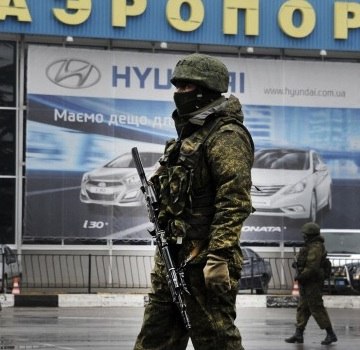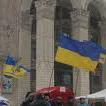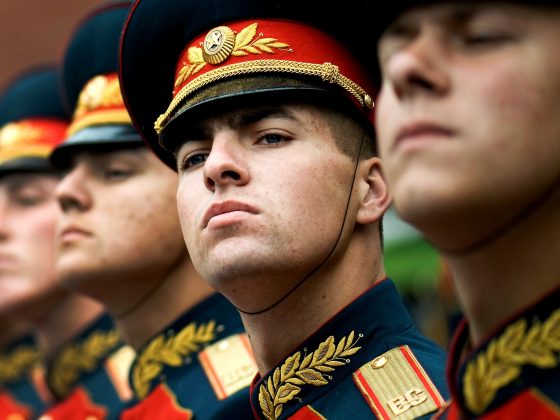The First World War has been described by some scholars as the war no one wanted. An alliance of Britain, France, and Russia was wary of the rising power of Germany, which in turn feared encirclement and armed itself in response. Actions that each coalition took to bolster its own defense were instead viewed as hostile by the other, leading to a dynamic of small, incremental steps that spiraled, ultimately, into a world war. On this centennial year of that event, we see similar dynamics of distrust, misperceptions, and fear at play in the current crisis in Ukraine. While the current crisis is (hopefully) unlikely to lead to a world — or any sort of — war, this is a good time to consider how actions in Ukraine might inadvertently lead to an escalation no one wants.
Currently, the situation in Ukraine is wrought with uncertainty, with several developments that have heightened the potential for an escalation into violence:
1) A dubiously legitimate government in Kiev that came to power after President Viktor Yanukovych fled the capital. The Ukrainian parliament followed legal procedures in impeaching him, but only after police deserted their posts throughout the capital. The United States and the European Union recognize the new government, while Russia does not.
2) Russian snap military exercises on the border with Ukraine, involving 150,000 troops.
3) The armed takeover of the government headquarters in the majority ethnic-Russian region of Crimea, and the flying of Russian flags.
All sides who have an interest in this crisis — the protesters and new government, the West, Yanukovych supporters, and Russia — come to these events with their own perceptions of how the country got to this point, the righteousness of their own cause, and the intentions of the other parties. Each actor has their own narrative, or story, that combines all these elements into a coherent picture and helps them make sense of the world. However, narratives are not accurate representations of recent events in Ukraine and tend to be self-serving. They attribute the most benevolent and sincere motivations to their own side while tending to disregard the interests and doubt the proclaimed intentions of their opponents.
Once these narratives are established, people are susceptible to confirmation bias, or the tendency to process new information in ways that confirm their existing beliefs. People tend not to be conscious of the tricks their mind plays on them, so their actions will reflect their biased thinking rather than a detached, objective view of the situation, much less one that takes into account the interests and misperceptions of their opponents. As applied to the current situation in Ukraine, here are some of the worrying dynamics at play that stem from misperceptions and mistrust.
1) Both the winners and losers in Ukraine (as of today) tend to view the other’s actions as manipulated by external powers. Russia’s position was that the protests had been initiated, or at least provoked, by the West, which sought to replace a democratically elected and Russia-friendly president with a pro-West government. Today, many in the Western media and pro-West Ukrainians assume that the protests taking place in Crimea are being stoked by Russia. The logic of external interference is seductive, and proponents of these claims loudly tout evidence to support their position, while dutifully ignoring evidence to the contrary. The effect of this belief is to disregard any possibility that one’s opponent’s interests are legitimate, and instead give license to demonize them as unpatriotic — worse, treasonous — patsies acting in the interests of a foreign power.
3) Among the “great powers,” this revolution is perceived as part of a longer-term geopolitical game. From the point view of some in the West, recent events represent a second attempt by Ukrainians to break free from Russia’s grasp and achieve their legitimate aspiration of joining the West. In the minds of (many more in) Russia, this is the second time a Russia-friendly president of Ukraine (Yanukovych both times, in fact) has been illegitimately overthrown in revolutions that put Western-oriented governments into power, coming on the heels of a similar revolution in Georgia in 2003.
2) As in World War I and some domestic conflicts, there is an emerging dynamic of a security dilemma: when defensive actions are perceived as aggressive, thus encouraging further measures for (incorrectly perceived) self-protection. Consistent with confirmation bias, both sides perceive new developments in ways that support their beliefs about the other side’s malign intentions. For example, the Ukrainian parliament’s revocation of a law that allowed regions to make Russian a second official language seems to confirm beliefs that the new government seeks to impose a Ukrainian-speaking nationalist agenda on Russian-speaking regions. Meanwhile, Russia’s military exercises fit a narrative about Russia’s drive for dominance in Ukraine and its intentions to intervene militarily. Both sides become even more certain of their rightness than they were before.
3) Like all protesters, those in the Maidan claimed to reflect the true will of the people. Certainly, their views on Europe and Yanukovych were supported by very many Ukrainians, but the reality is more complex. But if protesters who have entered the government believe their own cause to be unambiguously just — and are flush with euphoria after having prevailed against the forces of tyranny and a harsh Ukrainian winter — they will govern in the belief that they have “earned” the right to implement their agenda over the wishes of their adversaries and reject constraints on their power.
4) In such a fluid political environment, belief in conspiracies is pervasive. Even isolated actions by a small number of people will be seen not as incidental, but as part of a concerted campaign by malign forces. Especially in southern and eastern Ukraine, where the government’s hold on power is the most tenuous, there is a risk that individual recklessness or stupidity can be subsumed into preexisting narratives of machinations by more powerful actors, and therefore may provoke retaliation that perpetrators believe is justified.
5) In a tail-wagging-the-dog scenario, local actors who understand this dynamic can draw in outside powers who prefer to remain aloof.
As is the case when we struggle against psychological biases in our daily lives, the best remedy is to be aware of our biases, to actively adjust for them, and to try to see the world from other people’s point of view. For both the government and the West, though many are happy with the recent turn of events, there is perhaps an urge to gloat about the outcome. This is an ill-advised move to make against people who can spoil your party; a better approach is to recognize the perceptions of the other side and give them grounds to justify in their own minds that their loss is not total.
As the “winners” of the latest round of struggle who are also now tasked with passing laws that represent the entire nation, the new government has the greatest responsibility for heading off spiraling dynamics. Thus far, the results are discouraging, as the composition of the cabinet is not inclusive of Yanukovych voters, but instead appears designed to appeal to protesters who still occupy the Maidan. Yet even while it is considered too centrist by some on the Maidan, the government must assert its authority and — not having the legitimacy that comes from an election — be responsive to attitudes across the spectrum of Ukrainian public opinion.
See the original post © The Monkey Cage











